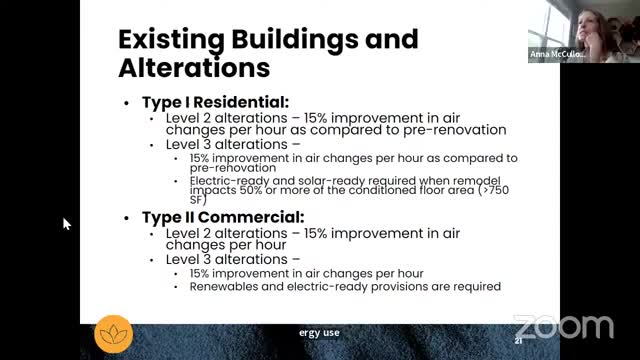Breckenridge introduces new energy efficiency requirements for residential alterations
April 27, 2025 | Energy Office, State Agencies, Organizations, Executive, Colorado
This article was created by AI summarizing key points discussed. AI makes mistakes, so for full details and context, please refer to the video of the full meeting. Please report any errors so we can fix them. Report an error »

The recent meeting of the Energy Code Board, hosted by the Colorado Energy Office, focused on significant updates to the Low Energy and Carbon Code, particularly regarding existing buildings and alterations. This meeting, held on April 27, 2025, highlighted the importance of enhancing energy efficiency in both residential and commercial sectors as part of Colorado's broader sustainability goals.
One of the key discussions centered on the requirements for existing residential buildings undergoing alterations. For Type 1 residential alterations, a notable mandate is the necessity to demonstrate a 15% improvement in air leakage rates. This improvement must be verified through testing conducted before and after construction. Similar standards apply to Type 2 commercial constructions, emphasizing the need for energy efficiency in both sectors. These measures are crucial as they aim to reduce energy consumption and improve indoor air quality, which can have significant health benefits for residents.
Additionally, the meeting addressed the integration of renewable energy solutions. The board discussed the "electric ready" and "solar ready" requirements that will be implemented based on the extent of alterations made to a building. This approach not only encourages the adoption of renewable energy sources but also aligns with Colorado's commitment to reducing carbon emissions.
The meeting also covered amendments to the residential International Energy Conservation Code (IECC) for Breckenridge and Summit. These amendments introduce compliance options that include a prescriptive pathway with mandatory requirements such as increased thermal insulation, high-efficiency appliances, and energy recovery systems. An alternative option allows for slightly less stringent insulation requirements but mandates the installation of solar arrays capable of offsetting 25% of a home's annual energy use. This flexibility aims to accommodate various homeowner circumstances while still promoting energy efficiency.
In conclusion, the discussions at this meeting reflect a significant step towards enhancing energy efficiency and sustainability in Colorado's building practices. The board's focus on existing buildings and the integration of renewable energy solutions underscores the state's commitment to reducing its carbon footprint. As these codes are implemented, they are expected to have a lasting impact on energy consumption patterns and environmental sustainability in the region. The board will continue to refine these measures, ensuring they meet the evolving needs of Colorado's communities.
One of the key discussions centered on the requirements for existing residential buildings undergoing alterations. For Type 1 residential alterations, a notable mandate is the necessity to demonstrate a 15% improvement in air leakage rates. This improvement must be verified through testing conducted before and after construction. Similar standards apply to Type 2 commercial constructions, emphasizing the need for energy efficiency in both sectors. These measures are crucial as they aim to reduce energy consumption and improve indoor air quality, which can have significant health benefits for residents.
Additionally, the meeting addressed the integration of renewable energy solutions. The board discussed the "electric ready" and "solar ready" requirements that will be implemented based on the extent of alterations made to a building. This approach not only encourages the adoption of renewable energy sources but also aligns with Colorado's commitment to reducing carbon emissions.
The meeting also covered amendments to the residential International Energy Conservation Code (IECC) for Breckenridge and Summit. These amendments introduce compliance options that include a prescriptive pathway with mandatory requirements such as increased thermal insulation, high-efficiency appliances, and energy recovery systems. An alternative option allows for slightly less stringent insulation requirements but mandates the installation of solar arrays capable of offsetting 25% of a home's annual energy use. This flexibility aims to accommodate various homeowner circumstances while still promoting energy efficiency.
In conclusion, the discussions at this meeting reflect a significant step towards enhancing energy efficiency and sustainability in Colorado's building practices. The board's focus on existing buildings and the integration of renewable energy solutions underscores the state's commitment to reducing its carbon footprint. As these codes are implemented, they are expected to have a lasting impact on energy consumption patterns and environmental sustainability in the region. The board will continue to refine these measures, ensuring they meet the evolving needs of Colorado's communities.
View full meeting
This article is based on a recent meeting—watch the full video and explore the complete transcript for deeper insights into the discussion.
View full meeting
